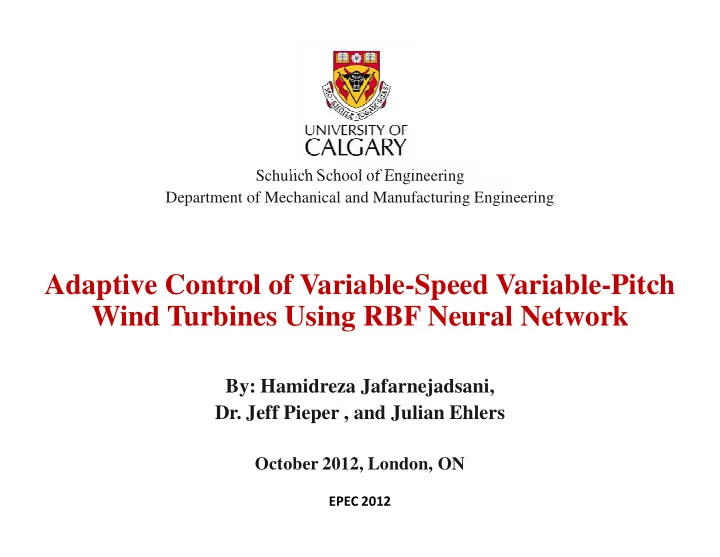

Schulich School of Engineering Department of Mechanical and Manufacturing Engineering Adaptive Control of Variable-Speed Variable-Pitch Wind Turbines Using RBF Neural Network By: Hamidreza Jafarnejadsani, Dr. Jeff Pieper , and Julian Ehlers October 2012, London, ON EPEC 2012
OVERVIEW • Introduction to Wind Turbine Control System 1 • Wind Turbine Modeling 2 • Torque Control Using RBF Neural Network 3 • Pitch Control Using RBF Neural Network 4 • Results of Simulations Using FAST Software 5 • Future Work: L 1 -Optimal Control of Wind Turbines 6 EPEC 2012 2
Wind Turbine Control System Outer Loop (slow time response) � Aerodynamics � Mechanical Subsystems (Drive Train and Structure) Inner Loop (fast time response) � Power Generator Unit � Pitch Servo [Ref:Boukhezzar, B., H. Siguerdidjane, “Nonlinear Control with Wind Estimation of a DFIG Variable Speed Wind Turbine for Power Capture Optimization] 3 EPEC 2012
Control Strategy and Objectives � Variable-Speed, Variable-Pitch Control Ideal power curve [Ref: Wind Turbine Control Systems, Page 51] � Control Objectives: 1) Energy Capture 2) Power Quality 3) Mechanical Loads EPEC 2012 4
Non-linear Equations of Wind Turbine � Drive-train shaft dynamics: � Elastic tower fore-aft motion: � Where: � : Rotor Speed • d: Tower top Displacement • λ : Tip-Speed Ratio • C p : Power Coefficient • V w : Wind Speed • T a : Aerodynamic Torque: • T el : Generator Torque • F a : Thrust Force • M t , C t , K t : Equivalent Mass, Damping • Ratio, and Stiffness of Tower EPEC 2012 5
Non-linear Equations of Wind Turbine λ : Tip-Speed Ratio • T a : Aerodynamic Torque • F a : Thrust Force • C p : Power Coefficient • Control Inputs: Generator Torque (T el ) & Pitch Angle ( β e ) • 6 EPEC 2012
FAST Wind Turbine Simulation Software � FAST : ( F atigue, A erodynamics, S tructures and T urbulence) is an Aero- elastic Simulator. Developed by NREL ( N ational R enewable E nergy L aboratory), Golden, CO � A V ariable- S peed V ariable- P itch Wind Turbine: NREL-Offshore-Baseline-5MW (Parameters developed by NREL) Rating 5 MW Rotor Orientation, Configuration Upwind, 3 Blades Control Variable Speed, Variable Pitch Rotor, Hub Diameter 126 m, 3 m Hub Height 90 m Cut-In, Rated, Cut-Out Wind 3 m/s, 11m/s, 25 m/s Speed Cut-In, Rated Rotor Speed 6.9 rpm, 12.1 rpm Rotor Mass 110,000 kg Optimal Tip-Speed-Ratio 7.55 Rated Generator Torque 43,100 Nm Maximum Generator Torque 47,400 Nm Rated Generator Speed 1174 RPM EPEC 2012 7
Radial-Basis Function (RBF) Neural Networks � RBF Neural Networks Approximate the Nonlinear Dynamics of Control System � Robust to Uncertainties and Disturbances in the System � Fast Time Response A two-point radial-basis function [Ref: Stanislaw H Zak, Systems and Control, pg 495] EPEC 2012 8
Torque Control � At wind speeds lower than rated wind speed � Maximum power capture � Constant Pitch Angle � Equation is in the affine form � RBF NN Approximator EPEC 2012 9
Control Design and Updating Rule Using Lyapunov Theory � Tracking error: � Controller: � Lyapunov function: � Robust weight update using e-modification method: EPEC 2012 10
Pitch Control � At wind speeds Higher than rated wind speed � Limiting the power capture at nominal capacity of wind turbine � Constant generator torque � Equation is in the non-affine form 11 EPEC 2012
Control Design and Updating Rule Using Lyapunov Theory � Transformation (Inverse Dynamics Method) � Approximating ideal controller using NN: � Mean value thorium: � Lyapunov function: � Robust weight updating rule : EPEC 2012 12
Wind Speed Profile EPEC 2012 13
Results (Electrical Output Power) EPEC 2012 14
Results (Control inputs) EPEC 2012 15
Results of Simulation Using FAST Software for Region I (Maximum Power area) Wind Inputs: TurbSim-generated 24 x 24 grids of IEC Class A • Kaimal-spectrum turbulence Six turbulence realizations per mean wind speed are simulated. • Electrical Power Output 3500 3000 2500 Power (kW) 2000 Neural Network Controller 1500 PI Controller 1000 500 0 0 2 4 6 8 10 12 Average Wind Speed EPEC 2012 16
Results of Simulation Using FAST Software for Region III (Rated Power Area): � Comparing The Performance of Controllers: 1) Gain-Scheduled PI-Control ( Developed by NREL) 2) Proposed Adaptive Neural Network Control EPEC 2012 17
Results (Electrical Output Power) EPEC 2012 18
Results (Control input1: Generator Torque) EPEC 2012 19
Results (Control input2: Pitch Actuation) EPEC 2012 20
Introduction to L 1 -Optimal Control � The final purpose of L 1 -optimal control is to find a controller (K) to stabilize the closed-loop system and minimize the L ∞ -norm between disturbance input(w) and performance output (z). Why L 1 -Optimal Control? � 1) Persistent exogenous disturbances and noises. These inputs obviously have infinite energy(L 2 -norm) . However, they have bounded magnitudes(L ∞ -norm) . EX: varying wind conditions that face the wind turbine. • � 2) Direct time-domain performance specifications EX: overshoot, bounded magnitude, bounded slope, or actuator saturation • LMI (Linear Matrix Inequality) Approach to L 1 -Optimal Control � LMI method results in a convex minimization problem subject to LMI constraints EPEC 2012 21
Thank You For Your Attention ?? EPEC 2012 22
Recommend
More recommend